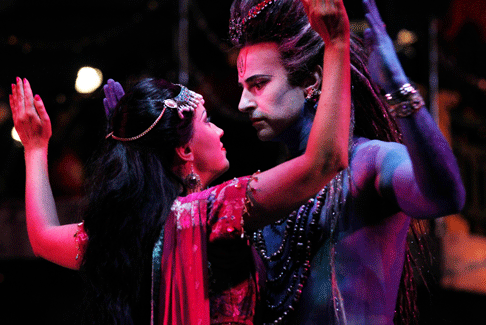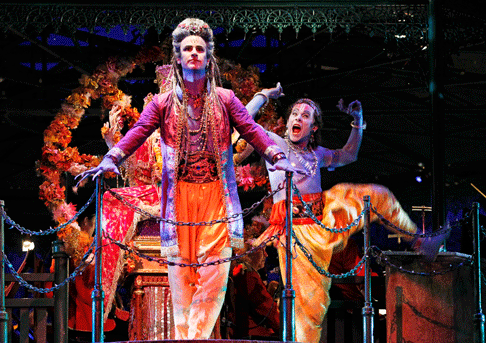But the result
made for a popular production. Dating from 1993 Luhrmann directed this long
before his rise to fame but his flair for exotica and rich visuals was apparent
even then. Luhrmann’s relocating of the story from ancient Athens to
1920s India cashed-in on the trend at the time for Bollywood movies and Indian
inspired fashion and dÈcor.
The world of Indian mysticism does, however, seem more suited to the
mysterious world Britten creates in his score. These spirit beings are to be
feared and to enter their realm should therefore be far more disturbing. Ravel
did the same in L’Enfant et les Sortileges, his enchanted garden
is an alluring but fearful place. So is Britten’s forest.
Having the fairies as Indian gods and the mortals as British Raj may confuse
the text and storyline and Luhrmann’s tendency to keep the action busy
often spoils the nocturnal, dreaminess of some of the music. An English
bandstand set in a park somewhere in India in 1923 dominates the set. The roof
becomes a platform where Oberon oversees his magical ministrations while on
stage level there is a pond below the bandstand where fairies and mortals meet.
The orchestra have been relocated from the pit to the middle level and, dressed
in military band uniform, are constantly in view as are the subtleties and
inventiveness of Britten’s score.
The loveliest of the opera’s scenes, where Tytania awakens to the
transformed Bottom is beautifully done here. Lorina Gore’s increasing
ecstatic and extravagant vocal lines float around Conal Coad’s trombone
accompanied bellowing and braying as Bottom.
With his genial, rollicking bass, Coad leads the mechanicals in their three
scenes with great success. In the guise of an army entertainment troop, the
effect is straight out of an English Music Hall parody of Italian opera along
the lines that Britten and librettist Peter Pears intended.
The quartet of lovers is superb. Henry Choo’s ardent and honey-voiced
Lysander sounds very much in the British tenor tradition. Choo’s first
scene with Hermia is beautifully sung. Even more so as he sang the repeated
“I swear to thee” phrases running up and down a staircase! Lisa
Harper-Brown’s plaintive soprano beautifully contrasts with Dominica
Matthews’s mezzo in the famous squabble that, here, becomes a cat-fight
ending with both splashing about in the pool. The physical prowess of Opera
Australia’s singers often matches their vocal prowess.
The most physical performance of all is Tyler Coppin’s as Puck. Nobody
seems to cast a boy in this part anymore as using an adult actor gives greater
opportunity to create a character. With his small stature Coppin has the best
of both worlds however, looking like an adult trapped in boy’s body. His
slapstick performance contrasts nicely with Tobias Cole’s stealthy,
almost sinister Oberon. Perched above the stage with waist length dreadlocks,
white face, blue, clawed hands and backed by Britten’s melismatic music
Cole’s performance reinforces this role as still one of the best in
modern operatic literature for a counter-tenor.
 Tobias Cole as Oberon and Lorina Gore as Tytania
Tobias Cole as Oberon and Lorina Gore as Tytania
In a sound-world all of its own, Oberon’s music benefited from
Cole’s restrained performance. With their prominence on the stage
Orchestra Victoria, lead by Britten authority Paul Kildea, were able to make
every nuance of the fairies’ scenes as well as the deliberately lumpen scenes
for the rustics and their play.
This Midsummer Night’s Dream was a run-away success when
first staged and, unlike any other production of a Britten opera, played to
full houses. The production was so popular it was presented at the 1994
Edinburgh Festival. The sheer vitality of the playing, singing and production
in this revival make any qualms about the logic of the setting fall away thanks
to the hallmark ensemble work of this company.
Michael Magnusson
 Tobias Cole as Oberon and Tyler Coppin as Puck
Tobias Cole as Oberon and Tyler Coppin as Puck
image=http://www.operatoday.com/MSDN_Australia_05.gif
image_description=Lorina Gore as Tytania and Joshua Tate as The Indian Prince [Photo by Jeff Busby courtesy of Opera Australia]
product=yes
product_title=Benjamin Britten: A Midsummer Night’s Dream
product_by=Oberon: Tobias Cole; Tytania: Lorina Gore; Puck: Tyler Coppin; Theseus: Jud Arthur; Hippolyta: Catherine Carby; Lysander: Henry Choo; Demetrius: Andrew Moran; Helena: Lisa Harper-Brown; Hermia: Dominica Matthews; Bottom: Conal Coad; Quince: Richard Anderson; Flute: Graeme Macfarlane; Snug: Shane Lowrencev; Snout: Andrew Brunsdon; Starveling: Samuel Dundas. Opera Australia Children’s Chorus. Orchestra Victoria. Conductor: Paul Kildea; Director: Baz Luhrmann (revival director: Julie Edwardson); Designers: Catherine Martin & Bill Marron; Lighting Designer: Nigel Levings State Theatre, The Arts Centre. December 4, 8, 11, 14, 16 & 18, 2010
product_id=Above: Lorina Gore as Tytania and Joshua Tate as The Indian Prince
All photos by Jeff Busby courtesy of Opera Australia